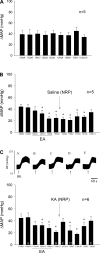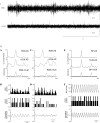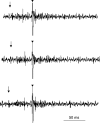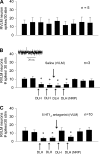Serotonergic projection from nucleus raphe pallidus to rostral ventrolateral medulla modulates cardiovascular reflex responses during acupuncture
- PMID: 20133441
- PMCID: PMC2867542
- DOI: 10.1152/japplphysiol.00477.2009
Serotonergic projection from nucleus raphe pallidus to rostral ventrolateral medulla modulates cardiovascular reflex responses during acupuncture
Abstract
We have demonstrated that stimulation of somatic afferents during electroacupuncture (EA) inhibits sympathoexcitatory cardiovascular rostral ventrolateral medulla (rVLM) neurons and reflex responses. Furthermore, EA at P5-P6 acupoints over the median nerve on the forelimb activate serotonin (5-HT)-containing neurons in the nucleus raphe pallidus (NRP). The present study, therefore, examined the role of the NRP and its synaptic input to neurons in the rVLM during the modulatory influence of EA. Since serotonergic neurons in the NRP project to the rVLM, we hypothesized that the NRP facilitates EA inhibition of the cardiovascular sympathoexcitatory reflex response through activation of 5-HT1A receptors in the rVLM. Animals were anesthetized and ventilated, and heart rate and blood pressure were monitored. We then inserted microinjection and recording electrodes in the rVLM and NRP. Application of bradykinin (10 microg/ml) on the gallbladder every 10 min induced consistent excitatory cardiovascular reflex responses. Stimulation with EA at P5-P6 acupoints reduced the increase in blood pressure from 41+/-4 to 22+/-4 mmHg for more than 70 min. Inactivation of NRP with 50 nl of kainic acid (1 mM) reversed the EA-related inhibition of the cardiovascular reflex response. Similarly, blockade of 5-HT1A receptors with the antagonist WAY-100635 (1 mM, 75 nl) microinjected into the rVLM reversed the EA-evoked inhibition. In the absence of EA, NRP microinjection of dl-homocysteic acid (4 nM, 50 nl), to mimic EA, reduced the cardiovascular and rVLM neuronal excitatory reflex response during stimulation of the gallbladder and splanchnic nerve, respectively. Blockade of 5-HT1A receptors in the rVLM reversed the NRP dl-homocysteic acid inhibition of the cardiovascular and neuronal reflex responses. Thus activation of the NRP, through a mechanism involving serotonergic neurons and 5-HT1A receptors in the rVLM during somatic stimulation with EA, attenuates sympathoexcitatory cardiovascular reflexes.
Figures







References
-
- Adams DB. The Behavioral and Brain Sciences. Brain Mechanisms for Offense, Defense and Submission. Cambridge, UK: Cambridge University Press, 1979, vol. 2
-
- Bago M, Dean C. Sympathoinhibition from ventrolateral periaqueductal gray mediated by 5-HT1A receptors in the RVLM. Am J Physiol Regul Integr Comp Physiol 280: R976–R984, 2001 - PubMed
-
- Bago M, Marson L, Dean C. Serotonergic projections to the rostroventrolateral medulla from midbrain and raphe nuclei. Brain Res 945: 249–258, 2002 - PubMed
-
- Barman SM, Gebber GL. Subgroups of rostral ventrolateral medullary and caudal medullary raphe neurons based on patterns of relationship to sympathetic nerve discharge and axonal projections. J Neurophysiol 77: 65–75, 1997 - PubMed
-
- Berman AL. The Brainstem of the Cat: A Cytoarchitectonic Atlas with Stereotaxic Coordinates. Madison, WI: University of Wisconsin Press, 1968
Publication types
MeSH terms
Substances
Grants and funding
LinkOut - more resources
Full Text Sources
Research Materials
Miscellaneous

